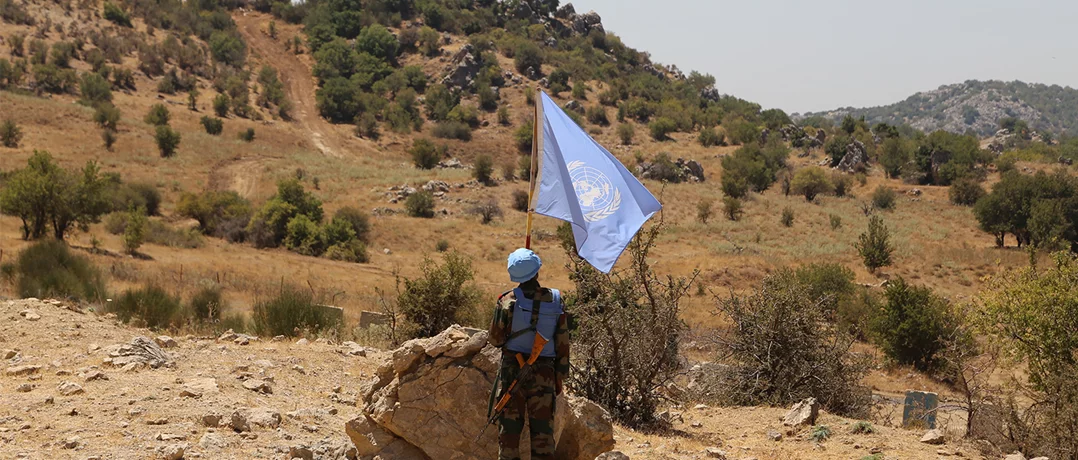The Shebaa Farms dispute endures as a flashpoint of contested borders, pitting Lebanon’s claims against international and regional politics.
Shebaa Farms at the crossroads: Lebanon, Syria, and the international challenge
Shebaa Farms at the crossroads: Lebanon, Syria, and the international challenge


More than two decades after Israel’s withdrawal from South Lebanon, the Shebaa Farms dispute remains one of the most intricate border issues in the Lebanese Syrian context and a recurring flashpoint in diplomatic and UN debates. Lebanon asserts ownership of the territory based on property deeds and historical records, while the international community continues to classify it as “occupied Syrian land.” This narrow strip thus symbolizes the collision of identities and sovereignties in an already fragile region.
The controversy never truly subsides, it reemerges with every political initiative or diplomatic effort, fueling calls to settle the question of sovereignty as a gateway to resolving Lebanon’s southern border and eliminating one of the key justifications for weapons outside state authority. Yet between the UN’s firm classification and Damascus’s reluctance to undertake formal demarcation, Lebanon faces a critical challenge: can it cement its claim to Shebaa through maps, documents, and sovereign assertion, or will the issue linger as a bargaining chip in the shifting arena of regional politics?
U.S. mediation or Israeli leverage?
Statements by U.S. Ambassador to Turkey and Special Envoy for Syria Tom Barrack clearly reflect Israel’s insistence on treating Shebaa Farms as “occupied Syrian territory.” Barrack emphasized that Washington cannot impose obligations on Israel and that Tel Aviv determines the framework for any settlement, raising questions about whether his role is simply to convey Israeli positions or to gauge Lebanon’s response.
This approach serves three strategic objectives for Israel:
1. Weakening Lebanon’s position by framing the issue as a matter of negotiation rather than affirming the right to reclaim occupied land.
2. Recasting the dispute from an international legal matter, grounded in the principle of withdrawal, into a set of political concessions dictated by Israel.
3. Leveraging the Farms in broader negotiations over Hezbollah’s weapons and the demarcation of borders.
Shebaa Farms: Who holds sovereignty?
The Shebaa Farms dispute remains mired in historical, legal, and diplomatic complexities, with conflicting documents fueling the controversy:
- Mapping the Contested Land: Lebanon relies on a 1966 official map showing the Farms within its borders. Yet the United Nations holds ten later Lebanese maps and six Syrian maps, all placing Shebaa within Syria, a discrepancy that undermines Lebanon’s position on the international stage.
- Land Ownership and Legal Claims: Beirut strengthens its case with land deeds, contracts, and court rulings from Hasbaya residents. While these documents establish local ownership, they fall short of proving full sovereignty without a formal border agreement with Damascus.
- The International Perspective: Since Israel’s 2000 withdrawal, the UN has maintained that Shebaa Farms lies outside Lebanese sovereignty. The Secretary-General’s 2005 report stated that “Shebaa Farms are not part of Lebanon, and any resistance to liberate them is not legitimate.” Meanwhile, UN Security Council Resolution 1701 (2006) limited UNIFIL’s mandate strictly to areas south of the Blue Line, leaving the broader territorial question unresolved.
Why Barrack’s Comments Stirred Diplomatic Tension
The remarks by Tom Barrack sparked controversy for several reasons:
· Clashing with U.S. Policy: His statements contradicted Washington’s official stance, which places greater emphasis on Hezbollah’s arms rather than border disputes.
· Sidestepping Formal Negotiations: Altering borders requires direct agreement between Damascus and Tel Aviv.
· Challenging Lebanese Red Lines: By implying that sovereignty over Shebaa Farms could be negotiable, the remarks touched on a core Lebanese national principle.
The Lebanese Claim
Since Israel’s withdrawal in 2000, Beirut has consistently maintained that Shebaa Farms are Lebanese, relying on Ottoman and French-era maps and judicial rulings. Historian Dr. Issam Khalife told The Beiruter: "Official documents and maps predating the French Mandate clearly place Shebaa within Lebanon’s borders."
The Lebanese Ministry of Foreign Affairs has reiterated to Barrack its commitment to internationally recognized borders and called on the United Nations to pressure Israel to withdraw from the area.
Dr. Khalife emphasized to The Beiruter: "Lebanon’s claim is not a political or emotional assertion, it is a fact grounded in documents, historical evidence, and international law. We have published three specialized books on this subject and submitted an 80-page detailed memorandum to the Cabinet supporting Lebanon’s position."
He explained that Lebanon has exercised continuous sovereignty over the area, pointing to the village of Nakhileh, south of the Farms, as a concrete example:
"Though rarely mentioned, Nakhileh demonstrates Lebanon’s authority. Since Hasbaya District joined Greater Lebanon in 1920, the state exercised full control, managing forest regulations, collecting taxes, issuing building permits, and appointing local officials. Even Minister Najib Al-Amyouni hailed from Nakhileh."
Khalife added: "Like other peripheral Lebanese regions, Syria attempted at times to assert control over the Farms. In 1944, Damascus tried to impose Syrian identity on Shebaa residents, but they rejected it outright. This resistance culminated in a formal agreement on February 20, 1946, between Lebanese land registry official Rafik Al-Ghazawi and his Syrian counterpart. Each represented their government, agreeing on the border, a deal still documented in official records today."
"After the 1967 war, Syria again tried to manipulate the map, placing the Farms under the Golan on the grounds of military use. But this claim has no legal basis. The UN, Israel, and major powers all recognize the Farms as Lebanese. Moreover, at least 15 public statements from Syrian officials themselves confirm this," he said.
Dr. Khalife concluded to The Beiruter: "Based on documents, land records, and official Syrian acknowledgments, there is no room for debate.
Shebaa Farms are Lebanese by every standard, and any delay in establishing this internationally reflects a Lebanese shortcoming, nothing more
Shebaa Municipality: “Documented and Undisputed”
The head of Shebaa’s municipality told The Beiruter: "Shebaa Farms are undeniably Lebanese, with ownership fully documented in official land records preserved in Sidon. The Lebanese state must take decisive action internationally, particularly at the UN and with Syria, to finalize border demarcation."
He emphasized that conflating UN Security Council Resolution 248, which pertains to the Golan Heights, with Resolution 425, on Israel’s withdrawal from Lebanon, is a serious legal mistake.
"Shebaa is occupied Lebanese territory and must be addressed under Resolution 425 without any ambiguity," he said.
The municipality also underlined the historical continuity of ownership. Residents cultivated the land prior to the 1967 Israeli occupation and maintained intermittent access under official permits during periods of control. Local memory preserves this connection, with the very name “Shebaa Farms” reflecting its historic link to the town.
"Even during the Israeli occupation in the 1980s, locals continued to harvest olives, a clear sign of ongoing ties," the mayor added.
The state must assume responsibility to assert Lebanon’s historical and legal rights over this land
The Syrian Narrative
Dr. Abdulrahman Al-Bitar, a Syrian historian and former head of the Homs branch of the Arab Writers’ Union, told The Beiruter:
"The Sykes-Picot borders still control us… Lebanon and Syria are names imposed by the occupiers."
For Al-Bitar, the roots of the Lebanese–Syrian border dispute lie in a colonial wound that has never healed. “Foreign powers drew these lines, and their artificial divisions continue to reproduce the problem in new forms,” he said, arguing that the border issue is not a technical matter but a sovereignty crisis born of colonial legacy.
Al-Bitar questioned the very terms underpinning today’s debate. “Even the names ‘Lebanon’ and ‘Syria’ as we know them are colonial constructs. True, they appear in historical texts, but without political meaning. ‘Lebanon’ simply referred to a mountain region in Greater Syria, as Boutros Al-Boustani’s 1880 dictionary makes clear. As for ‘Syria,’ the word was resurrected from ancient history and rebranded by European powers to fit their colonial project. For 1,400 years, the word ‘Syria’ was absent from Arab discourse until the West reimposed it.”
He explained that the French Mandate divided the “State of Greater Lebanon” from the “State of Syria” and placed Shebaa on Syrian maps. In practice, however, Shebaa’s residents remained Lebanese in identity and affiliation. “Maps were imposed, but never enforced. People stayed where they were, and the sense of Lebanese belonging took root,” Al-Bitar said.
He added that international agreements between France, Britain, the United States, and the League of Nations up to 1922 never mentioned Lebanon as a state. “All documents referred to ‘Syria’ as one entity. Even mandate charters and peace treaties used the term, because Lebanon then was no more than a geographic reference, not a political reality,” he noted.
So where did the real crisis begin?
According to Al-Bitar: “The borders drawn on maps were crude strokes dividing regions, without regard for villages and people. A clan’s land might fall on one side while their homes were on the other. That created the dilemma: were they Lebanese, Syrian, or something in between?”
Attempts in the 1930s to enforce these lines on the ground proved impossible. “A line from one mountain peak to another would cut through farmland or bisect villages. This led to years of adjustments, and only by 1939 were maps revised to reflect reality in northern Bekaa and the Sanjak of Alexandretta,” he explained.
For Al-Bitar, the region has always been one interwoven whole, not a patchwork of modern borders. “If the answer today is to build walls like Israel, ten meters high and endless in length, that would be a disgrace to anyone claiming civilization. What is needed is not walls, but a return to living history and geography, not the lines drawn in colonial backrooms,” he said.
He concluded with a warning: “The Assi River rises here and flows to the sea, just as the mountain snows connect the land. Are we to shred this natural and social fabric with foreign documents? Are we to bury memory under colonial ink? Lebanon cannot keep hiding behind statements."
True sovereignty begins by recognizing this historical truth: what we live today is the continuation of an imposed system that we ourselves have failed to dismantle
Pathways to Resolving the Shebaa Question
Lebanon’s bid to assert sovereignty over Shebaa Farms remains fraught with obstacles: contradictory maps issued after 1966, the absence of a formal border agreement with Damascus, and Syria’s wavering position. These gaps have allowed Israel and the UN to classify the territory as “Israeli-occupied Syrian land”, a framing that undercuts Lebanon’s ability to act unilaterally.
To move forward, experts argue Lebanon must present a consolidated historical, cartographic, and legal dossier, drawing on Ottoman and French maps, property deeds, and judicial rulings, while securing a binding border agreement with Syria to submit to the United Nations. Only then can Beirut hope to transform political rhetoric into enforceable international claims.
Possible Scenarios
1. Bilateral Demarcation
Direct negotiations with Damascus leading to a formal border agreement would provide Lebanon with its strongest legal foundation at the UN. This path, however, remains politically difficult amid broader Lebanese Syrian tensions.
2. Territorial Exchange or Partial Settlement
Proposals hinted at by U.S. envoy Tom Barrack envision land swaps or partial settlements. But such measures risk being perceived as sovereignty concessions, an outcome that would face fierce opposition at home.
3. Full Internationalization
Lebanon could intensify diplomatic efforts at the UN, leveraging Resolution 1701 and lobbying major powers to pressure Israel. This option preserves sovereignty but depends heavily on international alignment, which is uncertain.
4. Maintaining the Status Quo
The least ambitious path would leave Shebaa under UNDOF oversight, preserving its role as a bargaining chip in regional politics and as a justification for Hezbollah’s arms, without addressing the core sovereignty issue.
The Need for a Unified Lebanese Strategy
Lebanon can no longer afford a fragmented or partisan approach to Shebaa Farms. What is needed is a comprehensive national strategy: a meticulously documented legal, historical, and cartographic file, reinforced by sustained diplomatic engagement on the international stage.
For years, Hezbollah has invoked Shebaa as justification for retaining its arsenal under the banner of “resistance,” making the issue as much a domestic flashpoint as an external one. Any credible move to enshrine Shebaa’s sovereignty will therefore require a clear national consensus, forcing political forces either to rally behind the state or confront the erosion of the resistance narrative.
The cost of delay is steep. Prolonged inaction risks opening the door to externally imposed “land swaps” that could redraw Lebanon’s southern borders and shift regional balances without Beirut’s consent. The principle is straightforward: sovereignty cannot exist without unity, and secure borders cannot be achieved without a decisive national stance. Above all else, Shebaa must be elevated as a national priority, transcending political rivalries and sectarian divides.


